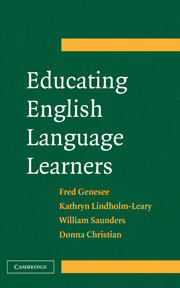3 - Literacy: Crosslinguistic and Crossmodal Issues
Published online by Cambridge University Press: 13 July 2009
Summary
INTRODUCTION
Crosslinguistic relationships between the L1 and the L2 as well as crossmodal relationships between oral and written language provide a basis for discussing research on the reading and writing development of ELLs. There are two fundamental and inescapable reasons why this is so. First of all, the learners under consideration, by definition, are acquiring literacy in English as a second language and have an ongoing developmental history in their first language. As a result, the relationship between their L1 and their L2 figures prominently in much of the research on reading and writing development in ELLs. In fact, relatively little research looks at L2 literacy development in ELLs without reference to their L1. Second, since reading and writing in any language implicate both oral and written modes of language, the relationship between oral and written language in the L1 and L2 of ELLs has also been a primary theme in much of the research reviewed here. The questions are: What is the relationship between oral and written language development? Is it the same for native English speakers and ELLs? The following specific relationships are examined in the sections that follow:
L1 oral proficiency and the development of L2 literacy,
L2 oral proficiency and the development of L2 literacy,
Specific component skills or abilities related to oral and written language and the development of L2 literacy, and
L1 literacy and the development of L2 literacy.
Information
- Type
- Chapter
- Information
- Educating English Language LearnersA Synthesis of Research Evidence, pp. 64 - 108Publisher: Cambridge University PressPrint publication year: 2006
Accessibility standard: Unknown
Why this information is here
This section outlines the accessibility features of this content - including support for screen readers, full keyboard navigation and high-contrast display options. This may not be relevant for you.Accessibility Information
- 62
- Cited by
